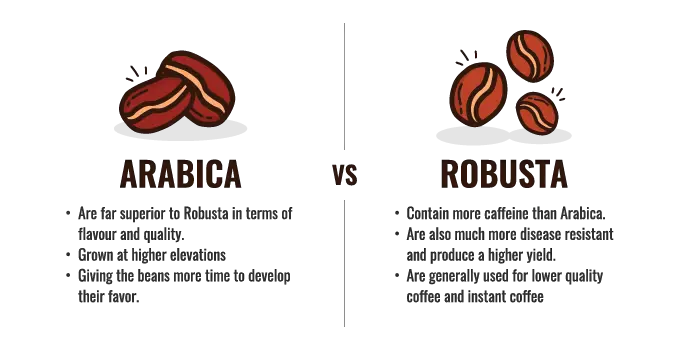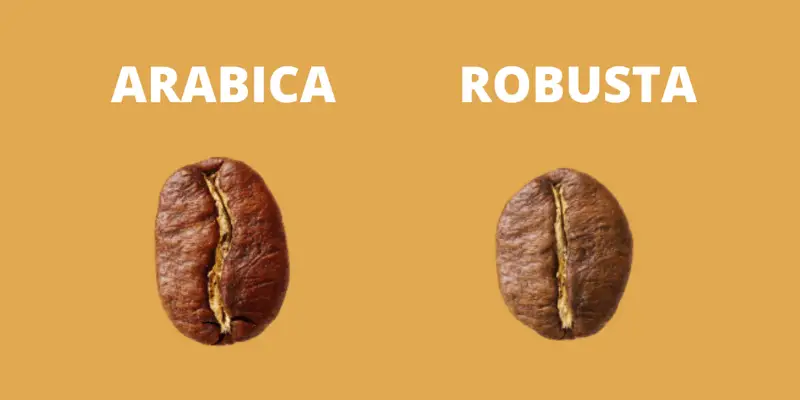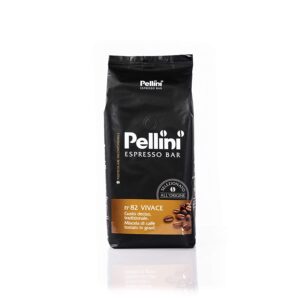
Coffee is probably the most popular drink on the planet, not including water. As a coffee enthusiast, I’m traveling the delicious landscape of my indulgence and I’m always looking for more. I understand how someone new to the community might have a hard time wrapping their head around this coffee business.
Questions such as what are all these different types of coffee beans? And where do they come from? What is coffee roasting? Are quite common. So, I decided to take you on a journey around our coffee bean community and get you some answers.
Whether you’re a coffee lover wanting to get to know your cup better or a student writing a paper on the origins of coffee, sit back we’ve got you covered.
Coffee Beans
First and foremost, let’s start with the basics of coffee beans. Even though over 100 different types of coffee species exist you only need to focus on two. Arabica and Robusta coffee beans account for nearly all the coffee consumption on the planet. In fact, you would have to go way out of your way to even try any of the other types.

Arabica Coffee Beans
We all regard Arabica as the mother of all coffee beans probably because it was the first type of coffee bean consumed. To this day it represents between 70-75% of total coffee production on the planet.
Arabica beans grow at higher altitudes. They like to hang out where it’s rainy and often look for shade. Some of the best Arabica beans can be found in Costa Rica, Ethiopia, Brazil, Columbia, Guatemala, Ecuador, Mexico, and Burundi.
They are known for their gentle and pleasant taste. Most coffee lovers describe the beans as having hints of chocolate, nuts, or even caramel.
The bean is also known for being rich in antioxidants and is beyond a doubt, the most pleasant type of coffee bean on the planet.
Robusta Coffee Beans
The second most popular bean on earth, Robusta, accounts for nearly 25% of today’s coffee consumption.
It originates from Africa and is known for growing in harsher climates with less access to water. Most of these beans come from Vietnam, India, Brazil, Indonesia, Guinea, Madagascar, the Philippines, and Thailand.
A cup of Robusta has over twice the amount of caffeine compared to a cup of Arabica coffee but tends to be less acidic.
Commonly used in espresso and instant coffee, Robusta beans pack a heavier punch than their fellow counterparts.

Liberica & Excelsa Coffee Beans
Totaling roughly 2-3% of the total world coffee supply the Liberica, and its variant Excelsa, coffee beans are relatively unknown in North America.
Originating in Southeast Asia the coffee beans became useful when a fungal disease, known as coffee rust, killed most Arabica plants in the area.
Grown predominantly in Indonesia, Malaysia, and the Philippines, Liberica are known for their distinct, woody, or smoky flavor, whereas Excelsa tends to have a sweeter, fruitier taste.
Some companies mix a little of Liberica or Excelsa into bags of the common beans to spice up their flavor.
Now that you know the different coffee bean species, where they come from, and the basics of their taste let’s talk about how they get from the plant to your cup. After the coffee beans are collected, they are put through a process called roasting which gives the beans their color and aroma.
Coffee Roasting
Before they are roasted coffee beans are green, hard, and without all their beautiful flavors. The goal of roasting all types of coffee beans is to get the perfect balance of sweetness, bitterness, and acidity.
Roasting can vary all around the world. Most sophisticated roastmasters have developed original techniques to treat the beans but they still share three common steps. First, the beans are dried to make sure all the water is removed. Then the coffee beans are heated up or roasted. They begin to crack, change color, and take on their future flavors. Finally, the beans are cooled down quickly so they don’t overcook or develop negative flavors.
Light Roast
Light roast coffee has characteristics easy to identify. The bean is light brown in color and tends to have a distinct crack in the middle, which often takes on a whiteish shade.
Generally, the flavor profile of light roast coffee can be described as crisp and earthy. This roast preserves the original qualities of the bean. These beans are high in acidity.
Medium Roast
A medium roast produces brown colored coffee with a beautiful aroma. They usually have little to no oil on the surface of the bean.
Here the earthy flavor of a light roast begins to develop into a balanced, sometimes sweet, full-body flavor profile. This coffee has medium acidity.
Dark Roast
When creating a dark roast, you want the beans to be dark brown in appearance and oily to the touch.
This roast has a deep profile and tends to work best for beans with chocolate, nutty, and caramel flavors. Dark roast coffee has slightly less caffeine than itself in a lighter roast. As you may have guessed this coffee is low in acidity, therefore often consumed by individuals with digestive issues.
You should know each bean has a unique response to different temperatures and roasting conditions. What works well for certain Arabica beans probably won’t suit Robusta as a roasting option. It’s important to understand roasting coffee is as much art as it is science.
Wrapping Up
I hope this article gives you a better understanding of our coffee community and different types of coffee beans.
The world of coffee can seem complicated, even intimidating. I believe, when broken down into simple terms it becomes easy to navigate and enjoy.
Remember, Arabica is the most common coffee bean around the world because of its pleasant taste. If you drink regular coffee with sugar, milk, or cream you are most likely having Arabica. If you like espresso or any of the espresso family drinks, you’re probably drinking Robusta coffee beans.
Although it’s nice to know what coffee is your favorite, experiment and take risks with new coffee as often as possible. Maybe just to expand your coffee horizons. Honestly, I’m still shocked at all the different coffee drinks that I find.
Related Questions
Which Country Grows the Best Coffee Beans?
Colombian coffee is known around the world for its rich flavor and unquestionable quality. Obviously, the idea of ‘best coffee’ can be different for each individual but it’s hard to dispute that Columbia makes some of the best coffee in the world.
How to Make Coffee Less Acidic?
If you’re concerned about acid reflux, heartburn, or even IBS resulting from drinking coffee there are a few simple ways to make coffee less acidic. Adding everyday household items like milk, and sugar can make your coffee easier on your stomach. If you are looking for a different way to reduce acidity in your coffee here is a link to the full article.
How to Make Coffee Taste Better Without Sugar?
There are a dozen different ways you can alter your coffee if you don’t enjoy the real taste of the coffee beans. A couple of common ways to sweeten your black coffee are brown sugar, chocolate chips, or cinnamon. Sweetened condensed milk is also an option.
If you are looking for ways to get rid of that harsh coffee taste you may be interested in an article: simple ways to add flavor to your coffee.
I’ve always seen coffee as a way of bringing people together. Everywhere I go people seem to enjoy a fresh cup of coffee and that’s what drives my passion. There’s always a new brew to master, and there’s always a new face to enjoy it with. Hitch a ride with me on a coffee-fueled adventure to find a perfect cup.


